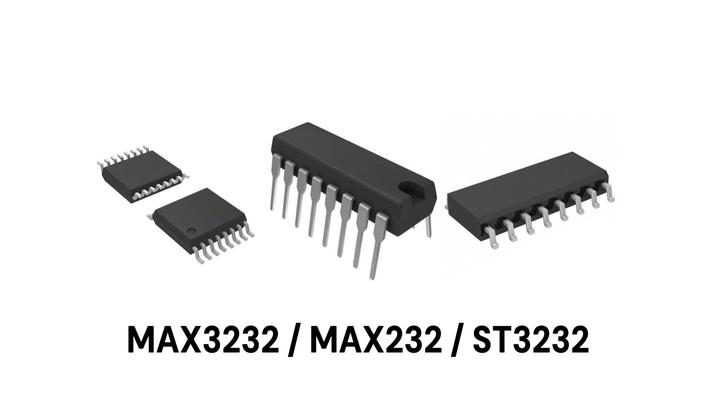
Introduction
Since its inception in the 1960s, the RS-232 interface has remained one of the most classic serial communication standards. Even today, despite the dominance of USB, Ethernet, and wireless communication, RS-232 is still widely used in industrial control, embedded systems, POS terminals, medical equipment, and networking devices.
Because RS-232 signal levels differ significantly from TTL/CMOS logic levels (±12V vs. 0–5V/3.3V), engineers must use dedicated RS-232 transceivers for voltage-level conversion. Different transceiver models vary in supply voltage range, data rate, power consumption, package type, and lifecycle status. A poor selection may lead to:
Incompatible supply voltage → device malfunction;
Insufficient data rate → data loss or latency in communication;
Using EOL devices → future supply shortages and project risks.
This article compares three common models—MAX3232ECPWR, MAX232CPE, and ST3232CDR —and provides a systematic selection guide based on application scenarios and design practices.
Parameter Comparison
MAX3232ECPWR | MAX232CPE | ST3232CDR | |
Manufacturer | TI | Maxim | ST |
Supply Voltage | 3.0V–5.5V | 4.5V–5.5V | 3.0V–5.5V |
Data Rate | 250 kbps | 120 kbps | 400 kbps |
Drivers/Receivers | 2/2 | 2/2 | 2/2 |
Power Consumption | Typ. 300 µA | Higher (Typ. >1 mA) | Typ. 300 µA, shutdown 1 nA |
Package | TSSOP-16 | PDIP-16 | SO-16 |
Status | Active | EOL | Active |
Key Features | ±30V input voltage tolerance, ±15kV ESD protection, industrial temperature range, wide voltage compatibility | Built-in charge pump, ±15kV ESD protection, classic model for legacy systems | Ultra-low power, ±15kV ESD protection, shutdown mode, industrial temperature range |
Application Analysis
MAX3232ECPWR (TI)
Supports both 3.3V and 5V systems, suitable for most new designs.
Industrial temperature range (-40°C to +85°C), ideal for harsh environments.
Built-in ±30V input voltage tolerance and robust ESD protection.
Applications: industrial PLCs, embedded gateways, POS terminals, medical device serial expansion.
MAX232CPE (Maxim)
Operates only at 5V, relatively low speed (120 kbps), higher power consumption, unsuitable for battery-powered or power-sensitive applications.
PDIP package, convenient for educational use or legacy system replacement.
This model is in the EOL stage, not recommended for new designs, but still valuable for maintaining and replacing legacy 5V systems. WIN SOURCE can provide continuous supply of such discontinued components.
ST3232CDR (ST)
Lowest power consumption: typ. 300 µA, shutdown mode only 1 nA, ideal for battery-powered systems.
Supports up to 400 kbps data rate for higher-speed serial communication.
SO-16 package, optimized for SMT mass production.
Applications: portable terminals, IoT modules, mobile payment devices, low-power data acquisition systems.
Design Considerations
Supply Voltage Matching
Modern designs mostly use 3.3V MCUs → MAX3232 / ST3232 are better choices.
Legacy 5V systems → MAX232 is compatible, but EOL.
Power Consumption
Battery-powered devices → ST3232 has clear advantages (shutdown current only 1 nA).
Industrial equipment → MAX3232 power consumption is acceptable, reliability prioritized.
Speed and Bandwidth
Standard serial applications (≤115.2 kbps) → all three are sufficient.
High-speed applications (>250 kbps) → ST3232 is recommended.
Package Selection
DIP (MAX232CPE) → suitable for prototyping or small-scale maintenance.
TSSOP / SOIC (MAX3232 / ST3232) → better for SMT mass production.
Common Pitfalls
Assuming MAX232 and MAX3232 are interchangeable:
Despite similar names, MAX232 operates only at 5V, while MAX3232 supports both 3.3V and 5V systems.
Overlooking power consumption:
In IoT or battery-based devices, using MAX3232 instead of ST3232 may lead to shorter battery life due to higher standby current.
Replacement Options
MAX232CPE → MAX3232ECPWR / ST3232CDR
For new designs, migration to MAX3232 or ST3232 is recommended for better voltage compatibility and lower power consumption.
For legacy system maintenance, MAX232CPE remains the most suitable direct replacement.
MAX3232 vs. ST3232
Power-sensitive applications → choose ST3232.
Industrial-grade reliability → choose MAX3232.
MAX3232ECPWR (TI): General-purpose industrial solution, wide voltage compatibility, high reliability, recommended for most new designs.
MAX232CPE (Maxim): Classic model, EOL, not for new designs, but essential for maintaining legacy 5V systems. WIN SOURCE ensures continuous supply for in-service equipment.
ST3232CDR (ST): Low-power + high-speed, ideal for battery-powered and portable applications.
Key Takeaways
3232 = New design first choice
232 = Legacy system maintenance
ST = Low-power high-speed
WIN SOURCE offers a full range of RS-232 transceivers from TI, Maxim, and ST, along with technical support. Engineers can quickly complete model selection and place orders according to project requirements. Visit WIN SOURCE for real-time inventory and lead time to avoid project delays.
© 2025 Win Source Electronics. All rights reserved. This content is protected by copyright and may not be reproduced, distributed, transmitted, cached or otherwise used, except with the prior written permission of Win Source Electronics.

COMMENTS